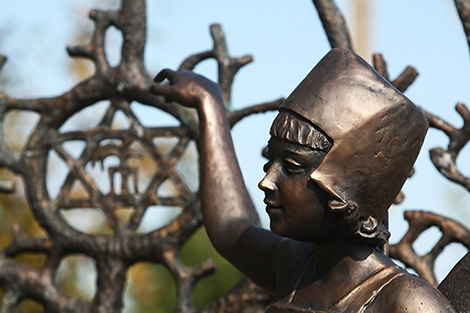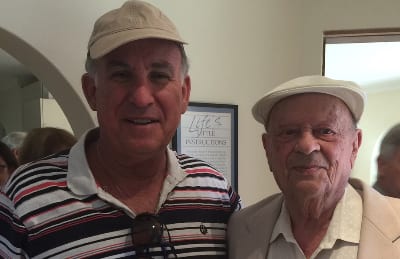Jewish Partisan Project and Lesson Plan

By Nance Adler HaMorah Nance Adler Middle School Judaics and Jewish History USHMM Museum Teacher Fellow Holocaust Center for Humanity – Powell Fellow nadler@jds.org An Inspirational School Pr…
Source: elirab.me/ed/
An Inspirational School Project
An Inspirational School Project

A Project For Your School We are seeking students who will recite or sing the Partisans’ Song in their home tongue, or in a language they have learnt. Please make a video, which can be as cre…
Source: elirab.me/znk/
The Meaning And Significance Of The Partisans’ Song
The Meaning And Significance Of The Partisans’ Song

A Video For Teachers MENU: Introduction – SABC TV Why is singing the song so Important? – Phillip Maisel Defiance Trailer – Bielski Jewish Partisans Soviet N…
Source: youtu.be/NRcGcNGrYWo
The Partisans’ Song – Genres
The Partisans’ Song – Genres

A Video For Teachers MENU: The Melody – Pokrass Brothers Original Russian Soundtrack Irish Folk Band – The Rathmines Japanese Version – Isao Oiwa Kugelplex K…
Source: youtu.be/_qeCD6lmMIM
The Partisans’ Song On Simcha TV
The Partisans’ Song On Simcha TV

The Global Partisan Song Project The Global Partisan Song Project Every year on Yom Hashoah – the Day of Remembrance of the Holocaust and Heroism, Holocaust survivors and Jewish communities sing th…
Source: elirab.me/simcha/
‘Never say you have reached the end of the road – WE ARE HERE!’
‘Never say you have reached the end of the road – WE ARE HERE!’

The imortal words of the poem written in Vilna by Hirsh Glik in 1943 continue to inspire as sung by young people worldwide today who identify with its message of hope.
Source: www.israelnationalnews.com/Articles/Article.aspx/21978
The Partisans’ Song – Triumph Over Adversity
The Partisans’ Song – Triumph Over Adversity

Yom Hashoah will be commemorated on 11/12 April at which the Partisan Song, Zog Nit Keynmol will be sung in Yiddish at ceremonies held around the world.
Source: www.jwire.com.au/the-partisans-song-triumph-over-adversity/
\Yom Hashoah 2018 – A video for your community
Yom Hashoah 2018 – A video for your community
Herzlia & Highlands House – The Partisans’ Song
Herzlia & Highlands House – The Partisans’ Song

On 8 February United Herzlia Schools hosted an international online collaboration on The Partisans’ Song Project Schools that participated in the online collaboration: Host: Herzlia Middle Sc…
Source: elirab.me/herzlia/
Muizenberg High School
Muizenberg High School

My Partisan Song Project presentation at Muizenberg High School Muizenberg High School principal Leonie Jacobsen and I first met on Thursday night, 8 February, at a delightful Yiddish music concert…
Source: elirab.me/mhs/
The Holocaust Survivors’ Anthem – #WeRemember
ORT Project Videos 2018 – The Holocaust Survivors’ Anthem
Source: elirab.me/ORT-2018
WORLD ORT IS IN ST. PETERSBURG, RUSSIA.
Maryusya Zarembo, an 8th grade student at ORT de Gunzburg School #550, is in awe of Hirsh Glick’s defiantly optimistic lyrics to Zog Nit Keynmol, the anthem of the Jewish partisans.
“This is the first time I’ve read or heard the poetry of someone from that time. It’s hard for me to imagine how he could have found the time or energy to be creative in those circumstances, but he did. And his verses are very powerful and life-affirming,” Maryusya said.
World ORT supports an initiative by Eli Rabinowitz to promote Zog nit Keynmol to new generations. Learning the lyrics, Maryusya said, had made her think about the Holocaust and its lessons for humanity.
“We have to learn that a person must not be humiliated or destroyed because of their ethnicity, faith or politics,” she said. “We can’t expect everyone to be a saint but the more we protect each other, the more tolerant we are, the stronger humanity will become. The alternative is extinction.”
Vilnius Jewish Community President and Daughters Sing Zog Nit Keynmol
THE TRANSLATION OF YIDDISH Introduction IN THE VIDEO:
Naomi: We are the Gurevich family from Vilnius, the Jerusalem of Lithuania.
Avital: My name is Avital. Here is my sister Naomi and our father Simon.
Naomi: Yiddish is a language that we speak at home and we love to sing songs in Yiddish.
Avital: One of the nicest songs is the song of the Jewish partizans – “Zog Nit Keynmol …… Mir zeyen do” – Never Say …… We Are Here!
Simon : I am very proud that with my wonderful kids, I have an opportunity to read and sing the words of Hirsh Glick, once sung by our grandparents.
Source: elirab.me/ort-vilnius/
WorldORT:
Children at the ORT Tekhiya School in Moscow (Центр Образования 1311 Тхия) recite the words of Zog Nit Keynmol, the famous anthem of the Jewish partisans. As part of World ORT‘s attempts to introduce the song to new generations, students at ORT schools around the world are this year exploring it as poetry. Here, students recite verses in Yiddish, Hebrew, English and Russian. #WeRemember
To learn more about Zog nit Keynmol, visit World ORT’s Music and the Holocaust website (http://holocaustmusic.ort.org/).
WeRemember – Zog Nit Keynmol
WeRemember – Zog Nit Keynmol

The Holocaust Survivors’ Anthem ORT Moscow Technical School 1311
Source: youtu.be/SL9FjpzCYNE
Arutz Sheva , Israel:
The traditional Holocaust Anthem is the Yiddish song Zog nit kan mol – Never say this is the end, also known as “The Partisan’s Song,,” written in 1943 by Vilna poet Hirsh Glik to a melody composed by the Soviet-Jew Dimitri Pokrass. The song’s powerful lyrics and rhythm raised the morale of fighters against the Nazis. World ORT is aiding in a campaign to introduce it to schoolchildren so that the next generation remembers it as well.
Holocaust Education Trust UK:
“Don’t Give Up Hope is an inspiring project which encourages students around the world to learn and sing Glik’s anthem” says HET’s Martin Winstone.
World ORT:
The thundering, defiant optimism of Zog nit Keynmol, “The Partisans’ Song”, raised the morale of fighters against the Nazis but it can also be an inspiration to new generations – if they know about it. To ensure that this magnificent song and its stirring message is not lost, World ORT is supporting Eli Rabinowitz in his passionate campaign to introduce it to schoolchildren around the world.
(Eli is on the far left of the picture with Stefan Bialoguski, Sadler Johnson, Cecile Dhour, Shoshana Kandel, and Daniel Tysman.)

Please watch this short video and join an inspiring project:
With each Yom HaShoah the number of Survivors dwindles making the challenge of engaging new generations more difficult and more urgent. But Australian film maker Eli Rabinowitz has found a way – and it’s inspired ORT students across the Former Soviet Union.
Eli has started an international push to popularise the partisan song Zog Nit Keynmol by linking ORT and non-ORT schools in an online programme to not only learn its Yiddish – or Hebrew – words but also to delve into its meaning and historical significance and to share what they learn.
The result has moved groups of students at World ORT schools in Kiev, Odessa, Kishinev, Vilnius, Chernivtsi, Tallinn, Moscow, Kazan, Samara and Mexico to prepare videos for Yom HaShoah singing the anthem written by the Vilna poet Hirsh Glik to a melody by the Soviet-Jewish composer Dimitri Pokrass.
“This is a powerful statement and shows that we can link the generations this way,” South Africa-born Eli said. “How many Survivors will be with us next year? Let’s honour them and their legacy. Yom HaShoah is such a significant day for them and for our youth – for all of us! We are all survivors!”

With Fania Brancovskaja, survivor, Vilnius, Lithuania

With Phillip Maisel volunteer at Jewish Holocaust Centre, Melbourne, Australia
This 4 minute interview with Phillip Maisel below highlights the importance of the Partisan Song, and the role of our youth in keeping alive the legacy of Hirsh Glik’s poem of hope!
Phillip, 95, was a friend of Hirsh Glik, and one of the first to hear this poem recited in the Vilna Gheto in 1943
Holocaust Memorial Day 2018
ZOG NIT KEYNMOL Poem by Hirsh Glik 1943
With words by Hirsh Glik and music by Dmitri and Daniel Pokrass, “Zog Nit Keynmol” became the anthem of the Jewish underground resistance movement in World War II. Hirsh Glik’s lyrics were combined with a march melody from the 1938 Soviet film Son of the Working People to create the inspiring song “Zog Nit Keynmol.” Following the end of World War II “Zog Nit Keynmol” has frequently been sung at Holocaust commemorations worldwide, particularly on Yom Hashoah.
The words to “Zog Nit Keynmol” reflect the author’s strong belief in Jewish armed resistance to Nazi oppression. Like many other partisan songs, “Zog Nit Keynmol” served to reinforce Jewish identity and maintain camaraderie in an environment where heroism was required and death was commonplace. Refusing to admit defeat or accept the possibility that Jewish life in Europe was doomed, the song’s lyrics are defiant and optimistic.
Knowing that Jewish communities in Eastern Europe were being destroyed all around them, Jewish partisans employed armed resistance to oppose Nazism. Glik’s lyrics to “Zog Nit Keynmol” helped to sustain the partisans as they risked their lives while forging another link in the long tradition of Jewish poetry dedicated to maintaining unity against hostile outside forces.
—William R. Ferneke
With teachers and students at Solomo Aleichemo ORT school, Vilnius

Hirsh Glik’s family tree

The Holocaust and the United Nations Outreach Programme
The Holocaust and the United Nations Outreach Programme

Source: www.un.org/en/holocaustremembrance/docs/paper26.shtml
Don’t Give Up Hope Project
An update for Holocaust Memorial Day
Study Guide
A lesson plan for teachers and learners
Timeline
How the project started & developed. This includes the original presentations.
The Poem
How it can be recited as a poem. Examples.
The Music
How the music was matched to the words
Records
Records and recordings
The Words
Now In 25 languages
Understand The Poem
Understand The Poem
The Partisan Poem in 104 languages.
Project Videos
The collection of the project videos
Hirsh Glik by Phillip Maisel
Phillip was a friend of Hirsh in the ghetto. He has a remarkable account to tell.
Hirsh Glik by Hershl Hartman
A tribute form 2002
Song Heard Around The World by Yuri Suhl
1953 article I found in the Dorot Library, NYPL
Hymn by Leizer Ran
1972 booklet I found in the British Library
Hirsh Glik by Martin Gilbert
The Song – Made in Vilna
How is still being sung in Vilnius today
Press
How the project has been reported around the world
Other Videos
A collection of videos
Library Resources
sourced & shared by Julia Monique Reichstein
Rachel Margolis
How Rachel matched the music to the words
Oscar Borecki
A tribute to a member of the Bielski Partisans
Different Genres
Different versions of the song
Protest Song
The famous recording of Paul Robeson and others
Memorials
Physical memorials to the song
Jewish Partisans
More information on the partisans
Partisans of Vilna
1986 Film
Defiance
2008 Film
War Poems
Photos from my visit to the British Library
Refugee Blues
WH Auden’s poem about German Jewish refugees
Antiwar Songs
An interesting website
Yad Vashem
Photos from my 2017 visit
Resources
Additional links
Prayer Books

Shmerke Kaczerginski Memoir
Kotkis
Workshop at the Holocaust Centre. Johannesburg
My visit In February 2017
Radical Yiddish

Reprinted from Radical Yiddish with permission of Joel Schechter.
When Yiddish Came to North Korea
When Yiddish Came to North Korea

On September 4, 1965, Lin Jaldati stepped onto a stage in Pyongyang, North Korea and quite possibly became the first person in Communist North Korea to sing in Yiddish. As I will discuss in a July 13 talk at the Yiddish Book Center’s Paper Bridge Summer Arts Festival in Amherst, Mass., Jaldati and her husband, Eberhard Rebling, became the voices of leftist Yiddish culture throughout the Communist world at the height of the Cold War.
Source: forward.com/schmooze/139725/when-yiddish-came-to-north-korea/



